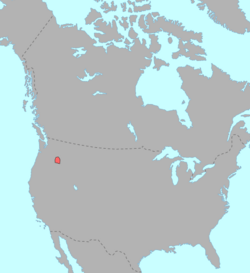Cayuse language facts for kids
Quick facts for kids Cayuse |
|
|---|---|

Pre-contact distribution of the Cayuse language
|
|
| Native to | United States |
| Region | Oregon |
| Ethnicity | Cayuse |
| Extinct | 1930slinglist |
| Language family |
Unclassified
|
| Linguist List | xcy |

|
|
The Cayuse language was a special language once spoken by the Cayuse people, a Native American tribe. They lived in what is now the state of Oregon in the United States. Sadly, the Cayuse language is now extinct, meaning no one speaks it anymore. The last speakers passed away in the 1930s. The Cayuse people called themselves Liksiyu.
Contents
What is an Unclassified Language?
The Cayuse language is known as an "unclassified language." This means that experts haven't been able to clearly link it to other language families. It's like a puzzle piece that doesn't quite fit with any other group of languages.
Some people thought Cayuse might be related to the Molala language, which was spoken by a tribe living south of the Cayuse. However, most experts believe any similarities were due to the tribes living close together and sharing words, rather than the languages being from the same family.
A famous language expert named Edward Sapir once suggested that Cayuse and Molala belonged to a group he called Waiilatpuan. This idea came from earlier work by Horatio Hale, who studied the Cayuse people in 1841. But because there isn't much information about the Cayuse language, and what exists isn't perfectly recorded, it's hard to be sure about its connections.
Words and Sounds of Cayuse
Even though the Cayuse language is no longer spoken, some words and phrases were written down by researchers a long time ago. This helps us learn a little about how it sounded and how sentences were put together.
Pronouns in Cayuse
Pronouns are words like "I," "you," "he," and "we." Here are some Cayuse pronouns recorded by Horatio Hale in 1846:
| I | iniŋ |
| you (singular) | nikí |
| he | nip |
| we | námək |
| they | nípik |
Another researcher, McBean, also recorded some pronouns:
| I | in ning |
| you (singular, plural) | in kai |
| he | neepe |
| we | nung naw naw |
Verbs in Cayuse
Verbs are action words, like "run" or "eat." They can change depending on who is doing the action or when it happened (past, present, future). Here are some examples of the verb "hungry" recorded by Henry Henshaw:
| I am hungry. | wi-tu-tŭnt |
| I was hungry. | kler-ka-wĭ-tu-tŭnt |
| I will be hungry. | wí-tu-näk-sŭnt |
And here are some forms of the verb "thirsty":
| I am thirsty. | nĭs-ka-mu-tiñg |
| I was thirsty. | nĭs-ka-mu-til |
| I will be thirsty. | nĭs-ka-mu-näk-skĭn |
In the early 1900s, a Molala speaker named Stephens Savage told a researcher that a few words were the same in both Cayuse and Molala. Experts think these words might have been borrowed from one language to the other because the tribes were neighbors.
Here are some examples of these shared words:
| sorrel horse | qasqasi tasiwitkwi |
| spotted horse | yuꞏk tasiwitkwi |
| black horse | múkimuki tasiwitkwi |
| comb | taꞏsps |
| spoon | ƚúꞏpinc |
Other researchers like Bruce Rigsby also collected some Cayuse words. However, the people they spoke to knew only a little Cayuse. They were usually more fluent in other Native American languages like Sahaptin or Nez Perce.
More Cayuse Words
Horatio Hale put together a list of almost 200 Cayuse words in 1846. Here are a few examples from his list:
Nouns
| gloss | Cayuse |
|---|---|
| man | yúant |
| woman | pintχlkaíu |
| boy | láutlaŋ |
| girl | staítχləŋ |
| father | pintét |
| mother | penín |
| house | niʃt |
| sun | huéwiʃ |
| moon | hátχltóp |
| water | iʃkáiniʃ |
| earth; land | liŋʃ |
| dog | náapaŋ |
| bird | tianíyiwa |
Adjectives
Adjectives are words that describe things, like "red" or "small."
| gloss | Cayuse |
|---|---|
| white | tχlaktχláko |
| black | ʃkupʃkúpu |
| red | lakaítlakaítu |
| good | suaíu |
| bad | luastu |
| small | etsáŋua |
| strong | ntáloa |
Numbers
Here's how the Cayuse counted:
| gloss | Cayuse |
|---|---|
| one | na |
| two | lépli |
| three | mátnin |
| four | pípiŋ |
| five | táwit |
| ten | niŋítelp |
| one hundred | niŋítalpuík |
Other Words
| gloss | Cayuse |
|---|---|
| today | páməŋ |
| tomorrow | tetχlp |
| yes | i |
| no | téehu |
Why Languages Disappear
The Cayuse language became extinct because fewer and fewer people learned it over time. This often happens when a community faces big changes, like new settlers arriving or being forced to move. When a language disappears, we lose a unique way of understanding the world and a part of a culture's history. That's why it's so important that researchers wrote down what they could about the Cayuse language before it was gone.
See also
 In Spanish: Idioma cayuse para niños
In Spanish: Idioma cayuse para niños

